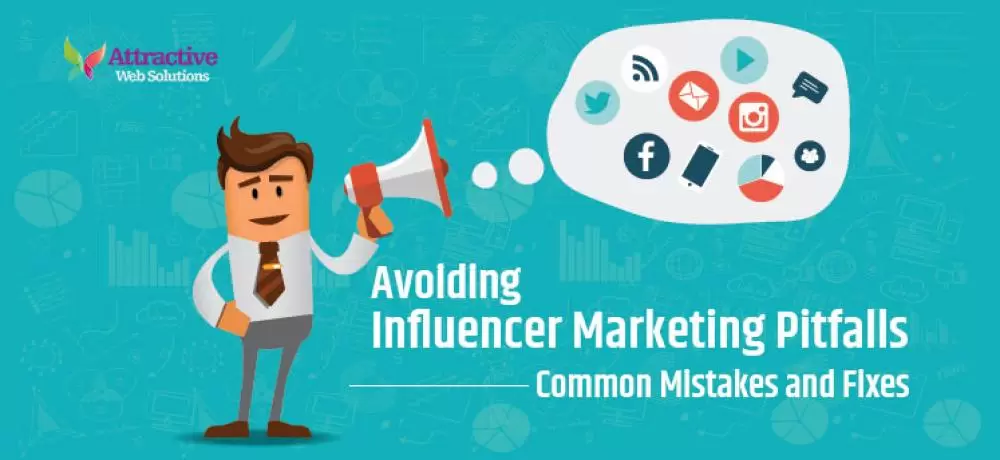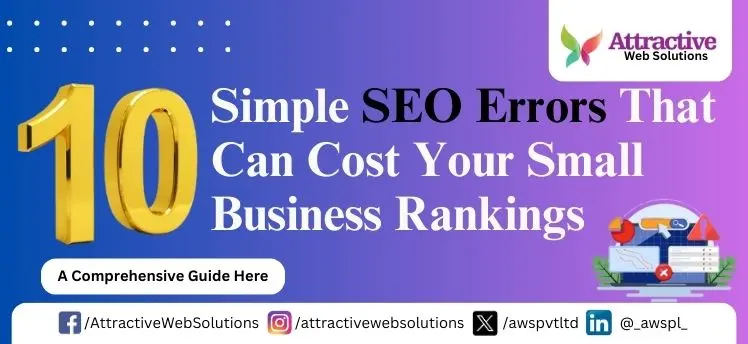Influencer marketing has become one of the most powerful tools for brand growth, helping businesses reach audiences with authentic, engaging content. However, as influential as it is, influencer marketing can be tricky if not done correctly. Many brands fall into common pitfalls that can weaken their campaign results and waste marketing budgets. As an expert digital marketing company, Attractive Web Solutions will walk you through the most common influencer marketing mistakes and, most importantly, how to fix them.
Why Do Influencer Marketing Campaigns Fail?
Influencer marketing campaigns can fail for various reasons, from selecting the wrong influencer to ignoring critical metrics. These mistakes can dilute your brand message, lead to poor engagement, and, ultimately, deliver a low return on investment (ROI).
Key Factors in Campaign Failures:
- Choosing influencers without thorough research
- Setting unrealistic goals or no clear objectives
- Ignoring authentic engagement and focusing on follower counts
- Poor campaign planning or unclear guidelines
- Lack of transparency with audiences
Common Influencer Marketing Mistakes and How to Avoid Them
1. Selecting Influencers Based on Follower Count Alone
Mistake:
Many brands make the mistake of choosing influencers with large followings, assuming this will guarantee success. While follower count can offer reach, it doesn’t necessarily mean high engagement or conversions. Influencers with inflated follower numbers or “fake followers” can result in a poor ROI and minimal audience impact.
Solution:
Look beyond the numbers and focus on engagement metrics. A strong influencer will have high engagement rates, indicating that their followers are genuinely interested in their content. Tools like Upfluence or HypeAuditor can help analyze influencer engagement and audience authenticity.
2. Ignoring the Importance of Niche Relevance
Mistake:
Partnering with an influencer who doesn’t align with your brand values or target audience is a common error. Even if they have an engaged following, if their niche doesn’t align with your product, the partnership won’t resonate with your target audience.
Solution:
Prioritize influencers who operate in your niche or closely related fields. For example, a skincare brand will see better results working with a beauty or wellness influencer than with a general lifestyle influencer. Conduct thorough research on influencers’ content and audience demographics to ensure alignment with your brand.
3. Setting Vague or Unrealistic Campaign Goals
Mistake:
Without clearly defined goals, it’s challenging to measure the success of an influencer campaign. Brands often start collaborations without specifying measurable objectives, leading to unstructured campaigns that lack direction and don’t deliver intended outcomes.
Solution:
Define specific, measurable goals for each campaign. Whether you aim for brand awareness, engagement, website traffic, or conversions, setting these benchmarks will help structure the campaign and make it easier to assess results. Use the SMART goals framework (Specific, Measurable, Achievable, Relevant, Time-bound) to ensure your campaign objectives are clear and attainable.
4. Overlooking the Power of Micro-Influencers
Mistake:
Brands may ignore micro-influencers, assuming they lack the reach of macro-influencers. However, micro-influencers often have more engaged, niche audiences and can deliver high-quality engagement rates.
Solution:
Consider micro-influencers as part of your influencer marketing strategy, especially if your goal is to reach a specific demographic. Micro-influencers typically have followers who trust their recommendations, making their partnerships more impactful for brands aiming to engage and convert.
5. Not Establishing Clear Campaign Guidelines
Mistake:
Without clear guidelines, influencers may produce content that doesn’t reflect your brand message or meet your expectations. This can lead to misunderstandings and inconsistent brand representation.
Solution:
Create a clear brief for your influencers with details on brand voice, key messages, campaign goals, content requirements, and any specific do’s or don’ts. Allow space for the influencer’s creativity to keep the content authentic, but ensure guidelines are provided for consistency.
6. Neglecting Authenticity and Transparency
Mistake:
Brands sometimes prioritize polished, branded content, which may appear overly promotional and lack authenticity. In addition, failing to disclose partnerships can erode trust between the influencer and their followers.
Solution:
Encourage influencers to create content that reflects their authentic voice and experiences. Transparency in disclosing sponsorships is essential; it not only aligns with legal requirements but also builds trust. An honest, authentic approach resonates better with audiences and enhances campaign credibility.
7. Failing to Track and Analyze Results
Mistake:
Launching an influencer campaign without tracking results is a missed opportunity to learn and optimize future efforts. Without data, you won’t know what worked and what didn’t, making it harder to refine your strategy.
Solution:
Set up tracking links, UTM parameters, or unique discount codes for each influencer to monitor performance. Track engagement, reach, click-through rate, and conversions. Use platforms like Google Analytics or Sprout Social to gather insights and evaluate each campaign’s ROI.
8. Overloading Influencers with Brand-Specific Messages
Mistake:
Some brands go overboard by dictating every aspect of the influencer’s content, which can make posts appear forced or insincere. This lack of creative freedom diminishes authenticity and negatively impacts engagement.
Solution:
While guidelines are essential, it’s crucial to respect the influencer’s unique style and voice. Allow flexibility in content creation so that influencers can present your brand in a way that feels natural to them and resonates with their followers.
9. Ignoring Long-Term Relationships with Influencers
Mistake:
One-off collaborations can be effective, but they don’t build a lasting connection between the influencer, the brand, and their followers. Switching influencers frequently can confuse audiences and dilute brand loyalty.
Solution:
Consider building long-term partnerships with influencers who align with your brand values. Long-term relationships enhance credibility and foster audience trust, as repeated exposure from a trusted source can solidify your brand’s presence.
10. Not Prioritizing Compliance and Legal Aspects
Mistake:
Overlooking legal obligations, such as failing to disclose sponsorships or not signing formal contracts, can create issues for both the brand and the influencer. Non-compliance can result in penalties and damage brand reputation.
Solution:
Prioritize compliance with FTC guidelines on disclosing sponsorships. Additionally, have a formal contract outlining the terms of the partnership, including compensation, timelines, content requirements, and disclosure obligations.
How to Fix Influencer Marketing Campaigns That Aren’t Working
If your current influencer marketing campaign isn’t yielding results, don’t worry. Here’s a quick guide to troubleshooting and optimizing underperforming campaigns:
Step 1: Assess Influencer Fit
- Review the influencers you’ve partnered with and determine if their audience aligns with your target demographic. If there’s a mismatch, look for influencers in a niche that better aligns with your brand.
Step 2: Adjust Content Strategy
- Consider whether the content resonates with the influencer’s audience. Work with influencers to pivot the content style or message to create something more engaging.
Step 3: Evaluate Engagement
- Monitor engagement metrics. Low engagement may indicate a lack of interest or authenticity. Engage influencers in creating stories, polls, or Q&A sessions to boost interaction.
Step 4: Refine Targeting
- Narrow down your campaign’s focus and target more specific audience segments. Use influencer platforms to identify new influencers with niche followings relevant to your brand.
Step 5: Test Different Content Types
- Experiment with different types of content, such as Instagram Stories, live streams, or Reels, to see what resonates best with the audience. Content variety often increases engagement and keeps the campaign fresh.
Avoiding influencer marketing pitfalls requires foresight, planning, and a commitment to authenticity. By carefully choosing relevant influencers, setting clear goals, maintaining authenticity, and tracking results, brands can unlock the full potential of influencer marketing. Remember, successful influencer partnerships are rooted in trust, transparency, and strategic alignment.
For expert advice on crafting and optimizing influencer campaigns that deliver measurable success, contact Attractive Web Solutions. Our team specializes in personalized digital marketing solutions to help your brand thrive in today’s competitive landscape.









0 Comments